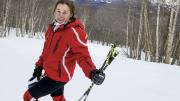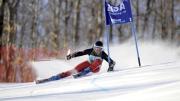To ski, even for good skiers, means to spend a lot of time sitting. For most people, skiing means a long drive from home to the distant snowy mountains and a similar voyage back. And if you’re an alpine/downhill (as opposed to cross-country) skier, each run begins with a ride on a ski lift, and that trip up the hill lasts a lot longer than the one down. In fact, the faster you ski, the larger the ratio becomes.
Downhill racer Rebecca Nadler ’14 of the Harvard women’s ski team can get to the bottom faster than any other woman collegian in America. She is the reigning NCAA champion in the giant slalom, the faster of the two alpine events (slalom and giant slalom, or “GS”) in which college ski teams compete. Last March, racing in the NCAA individual championships at the Bridger Bowl in Bozeman, Montana, Nadler became the first Harvard skier to win an NCAA championship. “The thought of winning hadn’t crossed my mind,” she says. “I knew where I matched up in the East, but the skiers out West are typically very strong.”
That’s true, and in addition, they are habituated to western snow conditions, which differ a bit from those on eastern mountains. “Eastern snow is a lot wetter—it’s compacted and it freezes, like an ice-skating rink on an angle,” says Tim Mitchell, Finnegan Family head coach of skiing, who mentors the Crimson alpine squad. “Out West, the snow is typically softer. Due to the higher elevations and the weather patterns, the snow is not so wet. I feel like it’s a disadvantage for the eastern skiers when the championships are on a western mountain.”
Indeed, Nadler was only the fourth woman from the Eastern Region to win an NCAA giant slalom title at a western site in 15 attempts. (There is some asymmetry: more than half the skiers at western colleges are Europeans used to Continental snow, which resembles that on eastern mountains, says Mitchell.) Earlier in the year, Nadler had set another Harvard milestone at the Williams Carnival (ski races that draw teams from many colleges are called “carnivals”) where her win in the giant slalom made her the first Crimson woman ever to win a downhill event.
“She’s a very, very powerful skier, especially for someone who is not super large,” Mitchell says. (Nadler stands five feet, two inches.) “Rebecca has always been a physically gifted skier. She’s technically very solid, and she’s very aggressive. One of her big assets is that she stays more positive than most athletes. In this sport there are often very challenging circumstances. Pushing through that, and not letting it get to her, is something Rebecca does exceptionally well. When she has a bad run, she uses it to motivate herself.”
Harvard’s regular season includes six carnival weekends in the Northeast, including the Eastern Intercollegiate Ski Association championships, followed by the NCAAs in March. (This year, the NCAA will hold its championships at Bread Loaf and the Snow Bowl in Middlebury, Vermont.) Each carnival includes slalom, giant slalom, and cross-country races for men and women. The slalom course is shorter, with lots of quick, short turns; the longer GS course, with fewer turns and a larger turn radius, produces faster speeds. Typical times are around 50 seconds for slalom, and a little over a minute for the giant slalom.
Collegiate races score the top three male and female finishers, based on rank order, not time. (The sport’s governing body, the Fédération Internationale de Ski [FIS] awards individual points differently, based on how far each runner-up finishes behind the winner in elapsed time.) Because snow and wind conditions vary so widely, absolute times mean very little in ski racing, but relative times in a given race matter greatly. In slalom and GS, each athlete takes two runs down the course, and the sum of the times recorded determines the order of finish.
Before the race, the skiers make an “inspection” run, sideslipping down the mountain to study the course: noting snow conditions and tricky turns, for example, and planning tactics. “If it’s a really challenging course full of sharp turns, you’ll want to ski smarter,” Nadler says. “But if there’s a lot of space between the gates and the course is more open, you can take more risks—let your skis run and carry more speed.” Tactics are fine, but “skiing is so unpredictable,” she says. “Races come down to tenths or even hundredths of seconds.”
In Bozeman, Nadler awoke on race morning to “the most beautiful day,” she recalls. Her strong morning run placed her second in the field. The top 30 finishers hit the course again for the second run, starting in reverse order of their earlier finish. This helps make the final results closer, because it’s generally better to ski earlier in the start order, before other competitors have roughed up the course. Still, Nadler had another good run in the afternoon, placing her fourth in that cohort, but the woman who finished ahead of her in the morning made a bad mistake and fell, catapulting the Harvardian into first place.
Nadler hails from Ottawa, where she grew up skiing with her family on weekends at the Tremblant Ski Club in Quebec, two hours away. By 15, she was racing in FIS events. She trained in Europe, made the Quebec team, and took two years off after high school to try ski racing, but was eventually disappointed in her results. “I’d lost sight of why I ski,” she says. “It wasn’t fun anymore.” Then she enrolled at the Carrabassett Valley Academy, a ski academy near Sugarloaf in Maine. “The coach there reminded me that I actually know how to ski. I always ski my best when I relax and have a good time.” A friend encouraged her to apply to Harvard. “I had only seen Harvard in movies,” Nadler says. “I didn’t know real people went there.”
Now she is one of them. Two or three mornings a week, Nadler rides in one of two team vans that leave around 6 a.m. for Crotched Mountain in New Hampshire, an hour and a half trip each way. (Sometimes they train nearby at Blue Hills Ski Area in Canton, south of Boston.) The team skis for an hour or 90 minutes, then is back in Cambridge in time for an 11 a.m. class. “When it was the only thing I was doing, I didn’t appreciate ski racing enough,” says the neurobiology concentrator. “Now, I am so busy with school and work that I really enjoy it more. My love for the sport only grows each year.” Coach Mitchell concurs. “You have to drag Rebecca off the hill at the end of the day,” he says. “She does not burn out. If the ski lift didn’t close, she would not stop skiing.”










